PGT Reducer Tee — One-Touch Pneumatic Reducer Tee for Compact, High-Speed Compressed-Air Installations
Overview: The PGT Reducer Tee is a one-touch pneumatic fitting engineered for rapid, tool-free connection and disconnection of tubing in compressed-air distribution systems. Its PC-type hex-profile construction and seal-coated threaded ports enable leak-resistant installation in tight spaces where fast servicing and compact piping breakout are required. Available in multiple metric and inch tube size combinations, the PGT Reducer Tee is optimized for branch distribution, machine tool air supply, control panels, and automated systems where space, speed, and reliability are critical.
Introduction
In modern industrial automation and compressed-air distribution, installation speed and serviceability are as important as pressure rating and flow capacity. Push-in (one-touch) fittings dramatically reduce assembly time compared with traditional compression or barbed fittings, and reducer fittings allow downsizing of branches without bulky adapters. The PGT Reducer Tee combines both capabilities in a compact, PC-type body that is optimized for confined installations. This article provides a comprehensive technical review of the PGT Reducer Tee, covering design intent, technical specifications, materials, installation guidance, use cases, performance considerations, comparisons to alternative fittings, and long-term maintenance recommendations.
This article is intended for pneumatic designers, plant engineers, maintenance technicians, and procurement specialists seeking in-depth technical information to evaluate the PGT Reducer Tee for industrial or OEM applications.
Technical Overview
The PGT Reducer Tee is a three-port push-in fitting allowing one tube size to branch into another tube size (reducer function) in a tee configuration. It is designed specifically for compressed-air media only, with working pressure up to 150 PSI (approximately 990 kPa) and an allowable vacuum down to -29.5 in Hg (-750 mm Hg / ~10 Torr). Typical operating temperature range is 0 to 60°C (32 to 140°F).
Functional highlights:
- One-touch connection: Insert the tube fully until it seats; the internal collet with retention teeth holds the tube under axial loads.
- Tool-free disconnection: Press the release sleeve and withdraw the tube; service or reconfiguration can be completed in 1–2 seconds.
- Reducer tee geometry: The fitting supports different tube outer diameters on the run and branch ports (e.g., metric-to-metric or inch-to-inch/inch-to-metric combinations).
- PC-type hex profile: The internal and external hexagonal profile facilitates wrench engagement and compact alignment in tight assemblies.
- Seal-coated threaded ports: The threads are pre-coated with a sealing compound to reduce the need for additional PTFE tape or thread sealant when properly installed.
Product coding follows the pattern PC + tube diameter + thread size (for example, PC06 1/8), and common models include metric combinations such as PGT 06-04, 08-06, 10-06, 10-08, 12-08, 12-10, 16-10, and 16-12, plus inch variants like 5/16-1/4, 3/8-1/4, 3/8-5/16 and 1/2-3/8. This range supports commonly used tube sizes for industrial pneumatic systems.
Specifications and Dimensions
The table below compiles the key technical specifications and representative dimensional data for the PGT Reducer Tee family. Values in the table are representative for typical PGT models—consult the manufacturer’s dimensional drawings for exact measurements for each model.
| Parameter | Specification / Range | Notes |
|---|---|---|
| Supported Media | Compressed air only | No liquids or aggressive gases; use in accordance with manufacturer’s guidance |
| Working Pressure | 0 to 150 PSI (0 to 990 kPa) | Max recommended continuous working pressure |
| Allowable Vacuum | Down to -29.5 in Hg (-750 mm Hg / ~10 Torr) | Suitable for vacuum-assisted pneumatic circuits within stated limits |
| Operating Temperature | 0 to 60°C (32 to 140°F) | Ambient/medium temperature; consult manufacturer for extended temperature variants |
| Tubing Options (metric) | Ø4 mm, Ø6 mm, Ø8 mm, Ø10 mm, Ø12 mm, Ø16 mm | Common PGT combinations — see model list below |
| Tubing Options (inch) | 1/4″, 5/16″, 3/8″, 1/2″ | Available in common inch combinations: 5/16-1/4, 3/8-1/4, 3/8-5/16, 1/2-3/8 |
| Thread Sizes | 1/8″, 1/4″, 3/8″, 1/2″ (thread type varies by variant) | Thread sealing is provided via a factory-applied coating; verify thread standard before installation |
| Body Profile | PC-type hex internal/external profile | Facilitates compact wrenching and alignment |
| Typical Body Materials | Nickel-plated brass / PBT (polybutylene terephthalate) / POM options | Material options depend on model; see Materials section for details |
| Seal Materials | NBR (nitrile) standard; FKM optional | Compatibility: standard compressed air; oil-laden air may require FKM seals |
| Estimated Weight (examples) | 6–25 g per fitting | Smaller metric models ~6–10 g; larger 1/2″ variants ~18–25 g |
| Typical Insertion Depth | 8–18 mm depending on tube OD | Tube must be inserted until it seats against the internal stop |
Representative model dimensional summary (approximate). Exact CAD/drawing data should be used for installation design.
| Model | Run Tube OD | Branch Tube OD | Thread | Overall Length (mm) | Width / Across Flats (mm) | Weight (g) |
|---|---|---|---|---|---|---|
| PGT 06-04 (PC06 1/8) | Ø6 mm | Ø4 mm | 1/8″ | 30 | 14 | 6 |
| PGT 08-06 | Ø8 mm | Ø6 mm | 1/8″ or 1/4″ | 34 | 16 | 9 |
| PGT 10-08 | Ø10 mm | Ø8 mm | 1/4″ | 38 | 18 | 11 |
| PGT 12-10 | Ø12 mm | Ø10 mm | 3/8″ | 44 | 20 | 16 |
| PGT 16-12 | Ø16 mm | Ø12 mm | 1/2″ | 56 | 24 | 22 |
| PGT 1/2-3/8 (inch) | 1/2″ | 3/8″ | 3/8″ | 58 | 24 | 24 |
Materials and Build Quality
The PGT Reducer Tee is engineered with materials selected for durability, low leak potential, and compatibility with compressed air. Typical construction materials and their respective technical justifications follow:
- Body material options:
- Nickel-plated brass: Common in industrial fittings for its strength, corrosion resistance, and thread integrity. Nickel plating reduces galling and improves appearance; brass bodies also provide good impact and temperature performance across the specified range.
- Engineering plastics (PBT or POM): Lightweight alternatives for compact automation and OEM panels. PBT (polybutylene terephthalate) and POM (polyoxymethylene) offer excellent dimensional stability, chemical resistance to residual oils in compressed air, and are electrically non-conductive—useful where galvanic isolation is desired.
- Collet / retention ring: Typically stainless steel or plated brass for retention teeth and to resist wear due to repeated insertion cycles. Stainless steel collets maintain grip and resist corrosion.
- Seals / O-rings: NBR (nitrile butadiene rubber) is the standard elastomer used for air fittings, offering good resistance to oils present in compressed air and excellent sealing performance across the stated temperature range. For installations where higher temperatures or chemical exposure is expected, FKM (fluoroelastomer) seals may be offered as an option.
- Thread coating: Thread ports are supplied with a factory-applied sealant coating. This reduces the need for manual PTFE tape or liquid sealants and helps prevent thread galling. The coating also simplifies assembly in high-volume production or in tight-access installations.
Build quality considerations:
- Precision molding or machining of the fitting body ensures consistent insertion depth and positive seating of tubing.
- Retention teeth geometry is optimized to balance high pull-out retention with low insertion force, minimizing tube damage while providing secure retention under pressure and vibration.
- Manufacturing tolerances for the internal seat and ferrule ensure repeatable sealing performance and low leak rates when used with properly prepared tubing.
- Quality control typically includes pressure/leak tests and visual inspection; reputable suppliers provide batch traceability and dimensional drawings to support design integration.
Key Features
The PGT Reducer Tee integrates a number of features that make it attractive for demanding pneumatic installations. Below are the primary technical features with explanation of how they impact system design and operation.
One-Touch Push-In Connection
Push-in fittings minimize assembly time. The PGT’s push-in design enables secure, repeatable connections in seconds without tools. The positive stop inside the fitting ensures correct insertion depth and improves sealing consistency compared to push-on barbed systems.
Tool-Free Disconnection
Maintenance and reconfiguration are simplified by a quick-release sleeve. Pressing the sleeve retracts the collet and releases the tube, allowing rapid servicing or rerouting of pneumatic lines without cutting or re-threading.
Reducer Functionality
The PGT integrates a reducer tee in a compact package—allowing a larger run tube to branch to a smaller tube (or vice versa depending on model). This reduces the need for separate reducer adapters and saves space in dense pneumatic manifolds.
PC-Type Hex Profile
The hex profile allows either internal or external engagement with a wrench or pliers in constrained spaces. This is particularly useful in valve islands, compact manifolds, or when fittings must be aligned precisely against panels or manifolds.
Pre-Sealed Threaded Ports
Factory-applied sealant on the threaded ports reduces assembly time and leak potential. It also reduces the risk of over-application of tape or sealant that can obstruct flow.
Wide Range of Tube Size Combinations
Availability in multiple metric and inch combinations (e.g., 06-04, 08-06, 10-08, 16-12, 5/16-1/4, 3/8-5/16) increases flexibility for system designers who must mix legacy inch tubing with metric tubing or create compact branch circuits.
High Pressure and Vacuum Capability
Rated to 150 PSI and to near full vacuum, the PGT supports both pressurized distribution and vacuum-assisted applications such as pick-and-place end-of-arm tooling when used within the manufacturer’s specified limits.
Low Profile, Lightweight Construction
Compact dimensions and low mass reduce load in mobile or vibration-prone equipment, and permit installation within tight enclosures without sacrificing strength or leak integrity.
Use Cases and Applications
The PGT Reducer Tee is broadly applicable across industrial and OEM pneumatic systems where compact branching, rapid service, and reliablity are required. Common applications include:
1. Machine Tool Air Distribution
On machining centers and CNC tools, compressed air is used for actuators, air blow-off, and coolant separation. The PGT Reducer Tee allows distribution from a common supply line into smaller branches that feed individual valves, blow guns, and air cylinders. The tool-free disconnection accelerates maintenance during tool changes or output verification.
2. Factory Automation and Robotics
Robotic cells and automated assembly lines use numerous small-bore pneumatic tubes to drive grippers, clamps, and cylinder actuators. PCP-type fittings with hex profiles fit between tight actuator clusters and allow quick rerouting when layouts are reconfigured between product runs.
3. Valve Manifold and Solenoid Valve Hookups
When integrating solenoid valves and manifolds, designers often require branching to smaller pilot lines. The reducer tee simplifies plumbing by eliminating the need for separate reducers and tees. The pre-sealed threads speed up manifold assembly and reduce leak points.
4. Packaging and Material Handling
Packaging equipment relies on speed, frequent changeovers, and compact machine frames. The PGT Reducer Tee supports quick reconfiguration and modular machine architectures in packaging, labeling, and cartoning lines.
5. Laboratory and Bench-Scale Systems
In laboratory pneumatic benches and test rigs where tubing sizes can vary, the PGT enables mixed-diameter networks for instrumentation, vacuum lines, and instrument air without specialized adapters.
6. Prototyping and OEM Product Integration
OEM designers value the PGT for rapid assembly during prototyping and short-run production. The combination of small size and one-touch fitting simplifies product servicing and end-user replaceability.
Flow and Performance Considerations
When selecting a reducer fitting, designers must consider its effect on flow, pressure drop, and system dynamics:
- Cross-sectional area change: Reducing tube diameter increases flow resistance and pressure drop. Use larger main runs for long supply lines and reserve reducer tees for short branch runs to maintain actuator response.
- Transient response: Small-diameter branches have lower effective volume and can pressurize or depressurize faster, improving response time for small actuators but increasing pressure loss under continuous demand.
- Leak rate: Push-in fittings have inherently low leak rates when properly installed; however, pressure drop across fittings may be higher than a straight union due to the internal geometry used to accomplish the reduction. Designers should consider this when sizing supply lines for multiple downstream branches.
- Tube material and inner surface roughness: Tubing with a smoother inner surface (e.g., nylon, polyurethane) reduces frictional losses compared to corrugated or kink-prone tubing.
For critical or high-flow systems, consider performing a simple pressure-drop calculation or bench testing with representative tubing and flow conditions. If high volumetric flow is required, avoid repeatedly reducing diameter across multiple segments and prefer parallel distribution manifolds sized to accommodate peak demand.
Comparison with Alternative Pneumatic Tee Solutions
The following comparison table outlines how the PGT Reducer Tee compares with common alternatives: standard push-in tee, compression reducer tee, metal (machined) tee, and barbed tees. The comparison focuses on installation speed, space utilization, reusability, leak potential, and suitability for tight spaces.
| Feature | PGT Reducer Tee (PC-type) | Standard Push-In Tee (non-reducer) | Compression Reducer Tee | Barbed Tee | Machined Metal Tee (threaded) |
|---|---|---|---|---|---|
| Tool-free Connection/Disconnection | Yes — one-touch insertion and sleeve release | Yes — one-touch | Typically no — requires wrench for nut compression | No — requires clamp and hose preparation | No — requires thread sealant and wrenches |
| Reducer Capabilities | Integrated reducer (multiple size combos) | Usually same-size ports only | Yes — available but bulkier | Possible with injection hose sizes but not precise | Yes — custom machining available |
| Installation Speed | Very fast | Very fast | Moderate — nut tightening required | Slow — hose prep and clamps | Slower — thread sealing and wrenching |
| Leak Potential (installed) | Low (seal-coated threads and push-in seals) | Low | Low when installed correctly | Higher (prone to clamp slippage) | Low if properly sealed |
| Space Utilization (compactness) | High (PC-type low-profile) | Moderate | Low (bulkier fittings) | Varies — hoses need bending radius | Low — requires wrench clearance |
| Reusability | High (many cycles; collet and seal wear over time) | High | Good | Poor to moderate | High |
| Best Use Case | Compact branch distribution; frequent service | General distribution | High-integrity joins where vibration is present | Low-cost, non-critical applications | High-pressure or custom manifolding |
Summary of comparison:
- PGT Reducer Tee excels where compactness, tool-free service, and integrated size conversion are needed.
- Compression fittings provide very robust joints suitable for higher pressures or harsher environments, but they require tools and occupy more space.
- Machined metal tees provide maximum mechanical robustness and can be used in custom manifolds, but they do not match the speed of push-in fittings for servicing and reconfiguration.
- Barbed fittings are inexpensive but less reliable and less suited to repeated reconfiguration.
Benefits and Limitations
Benefits
- Rapid assembly and serviceability: One-touch connection and quick release reduce downtime and installation labor costs.
- Compact footprint: PC-type hex profile allows tight mounting and easy wrench engagement in confined spaces.
- Integrated reducer: Reduces part count in systems that require mixed-size distribution and simplifies bill-of-materials management.
- Pre-sealed threaded ports: Factory-applied sealant minimizes leak risk and speeds up assembly.
- Wide variety of size combinations: Flexibility to match existing tubing infrastructure without adapters.
- Low weight: Useful in mobile or vibration-prone assemblies where mass matters.
Limitations
- Media restriction: Specified for compressed air only—do not use with liquids, oxygen, or aggressive gases unless explicitly approved by the manufacturer.
- Temperature range: Standard variants are limited to 0–60°C; for hotter environments, consult manufacturer for high-temperature elastomer/material options.
- Flow restriction: Reducer geometry inherently increases pressure drop relative to equal-diameter tees; for high-flow mains, avoid repeated reductions.
- Seal wear over cycles: Repeated disconnections will eventually wear seals and retention teeth; plan for periodic inspection and replacement intervals in high-cycle applications.
- Thread standard ambiguity: Thread types (BSPP vs NPT) must be verified when specifying; use the correct thread variant to avoid thread compatibility issues.
Installation and Maintenance Guide
Proper installation and routine maintenance maximize performance and service life. The following guidance is derived from established pneumatic best practices and is intended to be used alongside the manufacturer’s official installation instructions.
Pre-Installation Checklist
- Verify the PGT model matches the tubing OD and thread standard required for the application (metric vs inch threads; BSPP vs NPT).
- Confirm the system will operate within rated pressure (≤150 PSI) and temperature limits (0–60°C) for the fitting variant.
- Inspect tubing: use tubing that meets recommended OD and wall thickness for pressure and kink resistance; ensure tubing ends are cut square and are free from burrs.
- Clean system air supply to remove particulate that can damage seals—install filters and coalescing elements as required by system cleanliness and air quality standards.
Installation Steps
- Prepare tubing: Cut tubing square, deburr if necessary, and verify smooth outside diameter. Avoid using tube with nicks or scratches near insertion points.
- Insert tubing: Push the tube straight into the fitting until it fully seats against the internal stop. You should feel a slight increase in resistance as the collet engages.
- Check seating: Gently tug the tubing to verify it is retained and locked by the collet. For high-vibration applications, additional restraint of tubing runs (clamps or supports) is recommended.
- Install threaded port: Thread the fitting into its mating port. If the fitting variant includes pre-applied thread sealant, hand-tighten and then use a wrench to engage the wrench flats; final tightening should be firm but not excessive. Avoid overtightening which can crack plastic bodies or damage threads. If additional sealant is required, use an appropriate PTFE tape or approved liquid sealant sparingly.
- System leak test: After assembly, pressurize the system to working pressure and perform a leak check (soap solution, ultrasonic detector, or electronic leak detector). Correct any leaks with reassembly or component replacement.
Maintenance and Service
- Inspection intervals: Inspect fittings for leaks during regular preventive maintenance—typical intervals for industrial equipment range from weekly to monthly depending on duty cycle.
- Disconnection and reconnection: When disconnecting, depressurize the line before actuating the release sleeve. Clean the tubing end and inspect the seal and collet for wear before re-insertion.
- Seal replacement: Replace O-rings and seals if there is evidence of leakage or after a defined number of service cycles (manufacturer guidance). FKM seals may be used where oil or elevated temperatures are present.
- Collet integrity: Inspect the collet teeth for wear; repeated reconnections can dull retention teeth and reduce pull-out strength—replace fittings with compromised retention.
- Thread re-use: If a fitting is removed from a threaded port, clean residual sealant and inspect threads. Reapply a thin layer of recommended thread sealant if reusing the fitting—do not stack multiple layers of PTFE tape or sealant.
- Environmental exposure: Protect plastic-body fittings from prolonged UV exposure and aggressive chemical splashes; metal-body fittings are preferred for corrosive environments.
Troubleshooting Common Issues
- Leak at tube entry: Ensure tube is fully inserted and cut square. Remove and reinsert the tube; if leakage persists, inspect and replace O-ring or the tubing if damaged.
- Leak at threaded joint: Disassemble and clean threads, then reapply appropriate thread sealant. Avoid over-tightening; if thread damage is present, replace the fitting or mating component.
- Tubing slips out: Check for damaged collet teeth or incorrect tubing OD. Replace the fitting or use the correct OD tubing. For high-vibration applications, consider additional clamp support or compression fittings.
- Difficulty inserting tubing: Confirm inner diameter and insertion depth. Check for obstructions, debris, or internal damage. If fittings incorporate a push-in sleeve lock, ensure the sleeve is not stuck in the released position.
Procurement and Specification Tips
When specifying the PGT Reducer Tee for a procurement or engineering bill-of-materials (BOM), consider the following:
- Specify tube OD combinations precisely (e.g., PGT 08-06 for Ø8 mm to Ø6 mm) and indicate metric or inch variants clearly in the BOM.
- Confirm thread standard (BSPP vs NPT vs metric) and whether pre-sealed threads are acceptable for the mating component. For international projects, explicitly state thread standard on purchase orders.
- Request material options if environment dictates (nickel-plated brass for corrosion resistance, PBT for electrical isolation and lightweight applications).
- Request manufacturer’s pressure/leak test certificates or product data sheets to support quality assurance and compliance documentation.
- Consider ordering spares (seal kits or spare fittings) for high-cycle or critical systems to reduce downtime.
Regulatory and Safety Considerations
Although the PGT Reducer Tee is a low-risk passive component, safety and regulatory considerations include:
- Media limitation: This product is specified for compressed air only—do not use with oxygen, combustible gases, or liquids unless the manufacturer certifies compatibility.
- Installation safety: Isolate and depressurize systems before disconnection to avoid sudden blow-off of tubing or damage to operators.
- Pressure rating: Ensure the system pressure never exceeds the fitting’s rated working pressure (150 PSI). Consider safety factors for dynamic pressure spikes.
- Material compatibility: Verify that seal materials (NBR, FKM) are compatible with lubricants or additives used in the compressed-air system.
Real-World Examples and Design Considerations
Example 1 — Pneumatic Pick-and-Place Cell:
A packaging plant retrofits its pick-and-place cell to add additional vacuum suction cups. Existing supply runs are Ø10 mm, and the design requires multiple Ø6 mm pilot lines to feed individual valves. Using a PGT 10-06 reducer tee, designers install multiple branches with minimal piping complexity. The one-touch connections reduce installation time by over 60% compared to using separate reducers and compression tees, and the hex profile allows fitting installation in the confined space between the robot base and guarding.
Example 2 — Valve Bank Rebuild:
During a valve bank rebuild, maintenance staff replaces manifold plumbing with pre-assembled sub-harnesses using PGT reducer tees to transition from a 12 mm supply to 8 mm pilot lines. The pre-sealed threads speed manifold reassembly and minimize leak-causing human factors, improving first-pass leak test yield.
When Not to Use the PGT Reducer Tee
There are scenarios where the PGT is not the ideal choice:
- High-temperature air (>60°C) or processes requiring steam—seek high-temperature-rated fittings.
- Systems handling liquids, hydraulic fluids, oxygen, or other media not approved by the manufacturer.
- Applications with very high flow demand where repeated reductions will create unacceptable pressure drop—consider manifold or larger diameter distribution solutions.
- Environments with chemical exposure known to degrade the selected body or seal materials—choose corrosion-resistant alloys or specialty elastomers where required.
Conclusion
The PGT Reducer Tee is a technically robust, compact, and service-friendly one-touch fitting suited to a wide range of compressed-air distribution and branch applications. Its integrated reducer capability, PC-type hex profile, and pre-sealed threads reduce installation time, lower leak potential, and save space—key advantages for modern automated equipment and dense pneumatic assemblies. Engineers and maintenance teams should, however, weigh its benefits against the flow implications of reducing tube diameter and the media/temperature limitations. By following correct installation practices and routine maintenance, the PGT Reducer Tee can simplify system design, accelerate uptime, and reduce total installed cost across industrial and OEM pneumatic systems.
For precise dimensional drawings, flow data, and material certifications for specific PGT models, request the manufacturer’s product datasheet and CAD files during specification and procurement.
Keywords (for SEO): PGT Reducer Tee, one-touch pneumatic fitting, push-in reducer tee, compressed air fittings, PC-type hex fitting, quick-disconnect pneumatic, metric-inch tube reducer, pre-sealed threaded pneumatic tee.

 Tiếng Việt
Tiếng Việt
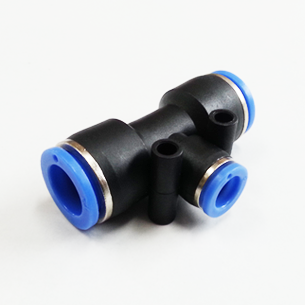
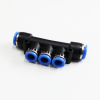
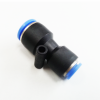
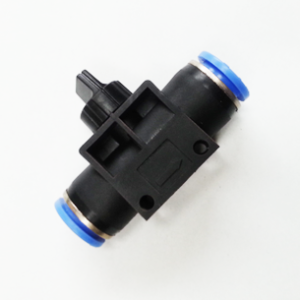
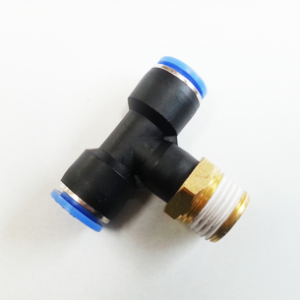
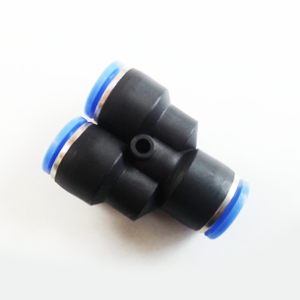
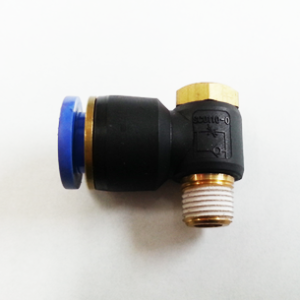

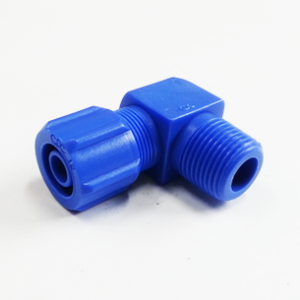
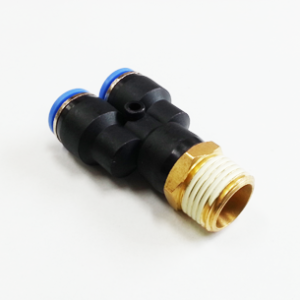
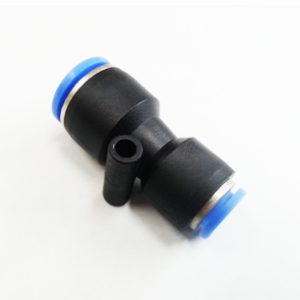
Reviews
There are no reviews yet.